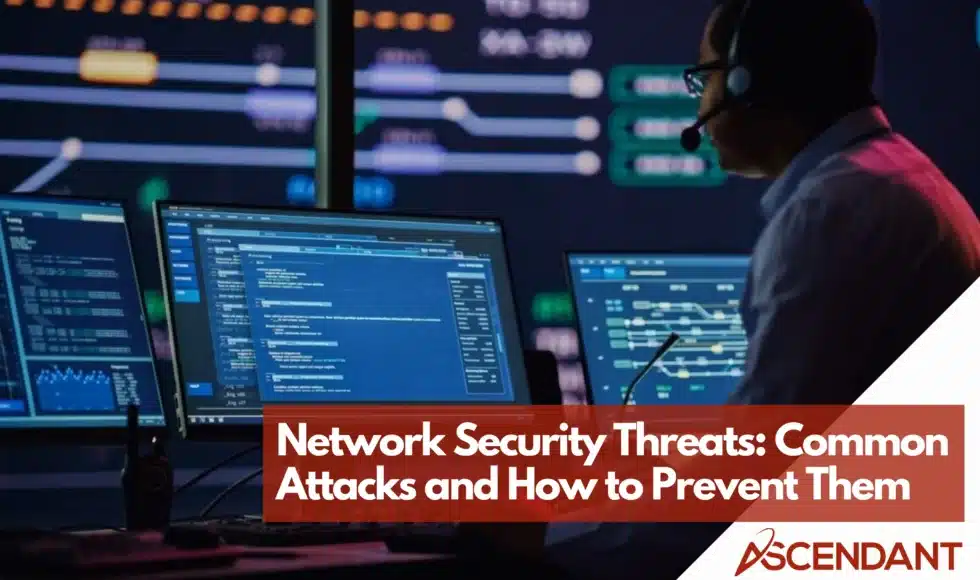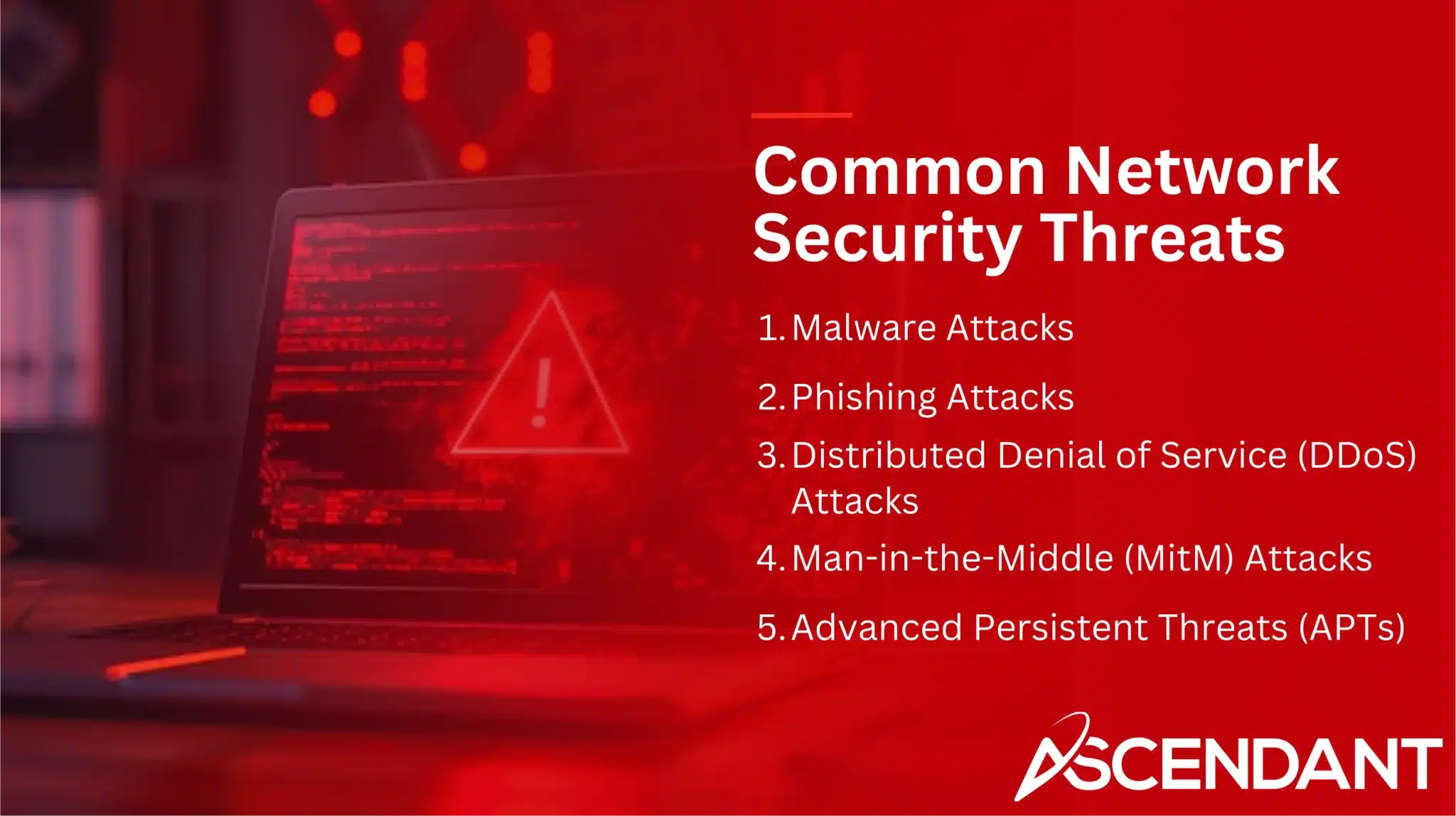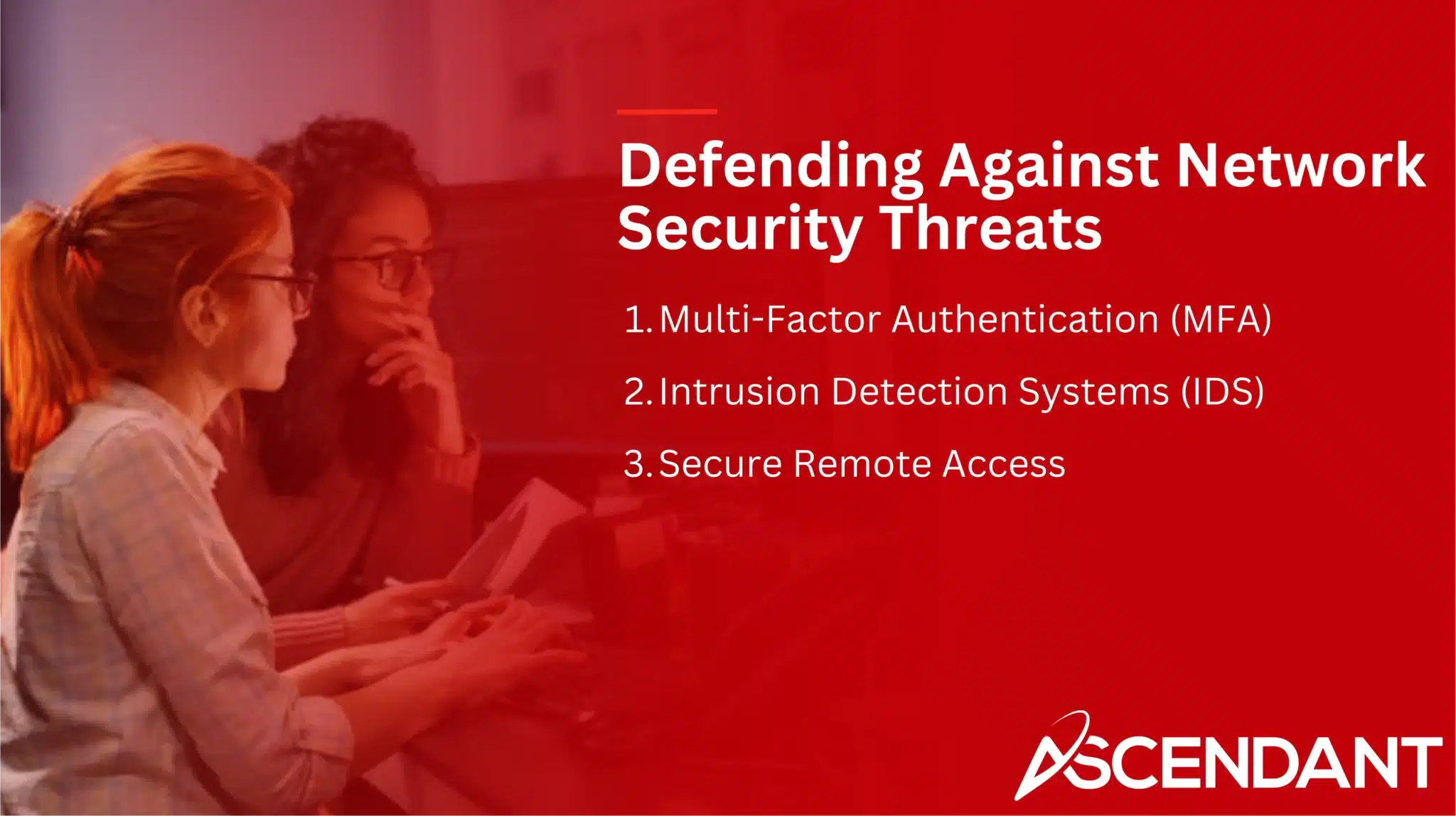Network security threats, like malware, phishing, and DDoS attacks, can endanger your data and disrupt operations. This article outlines these common threats and offers strategies to protect your network.
In This Article:
- Understanding Network Security Threats
- Common Network Security Threats
- Emerging Cybersecurity Threats for 2025
- Vulnerabilities Leading to Network Security Threats
- Defending Against Network Security Threats
- Protecting Sensitive Data
- Incident Response and Recovery
Key Takeaways
- Understanding and identifying network security threats, such as malware, phishing, and DDoS attacks, is crucial for developing effective defense strategies.
- Emerging threats, including cryptojacking and fileless malware, require advanced detection techniques and proactive security measures to mitigate risks.
- Implementing multi-factor authentication, regular security audits, and incident response plans are essential components for maintaining network security and protecting sensitive data.
Understanding Network Security Threats
Technological hazards that compromise the defenses of an enterprise network, leaving it vulnerable to breaches and invasions, are referred to as network security threats. These dangers stem from a multitude of origins such as insider threats, state-sponsored actions, and malicious software. The swift advancement in cyber threats poses substantial obstacles for sustaining robust network security. It is vital to recognize the devices linked to a network along with their possible weaknesses for preserving effective protection.
An all-encompassing strategy towards safeguarding one’s digital framework involves not only technological countermeasures but also operational tactics meant to protect both the users and data within the system alongside its entire infrastructure. Actions taken typically involve enforcing stringent security protocols alongside ongoing scrutiny of incoming and outgoing traffic while also raising awareness among personnel about potential cybersecurity risks they might encounter. Predominant kinds of these menaces include malware attacks perpetrated by rogue elements within organizations or complex blended methods designed specifically to undermine protective measures in place.
The aftermath stemming from such incursions into cybersecurity can wreak havoc resulting in operational interruptions, financial losses, or even erosion of consumer confidence. Particularly insidious are those maneuvers undertaken by governmental entities which constitute formidable adversaries against global defense mechanisms pertaining primarily to due networks spanning internationally. Continuous vigilance coupled with preventive action remain imperative for institutions committed to staunchly defending against dire vulnerabilities inherent within their respective cybersecurity frameworks—foremostly through enlightenment on origination points behind this myriad array spectrum concerning electronic perilousness when forging ahead crafting tactical impediments effectively repelling said hostilities.
Common Network Security Threats
Common network security threats include a variety of malicious activities that can compromise the integrity and confidentiality of network systems. These threats encompass malware attacks, phishing schemes, and Distributed Denial of Service (DDoS) attacks, each posing unique risks to network security.
Understanding these threats in detail is crucial for implementing effective defense mechanisms.
Malware Attacks
Malicious software, abbreviated as malware, refers to intentionally designed code that disrupts normal computer functions. Various forms of this malevolent software exist, such as viruses, worms, ransomware, adware, and Trojans. Such insidious programs can penetrate network devices via email links or harmful downloads causing significant disruption in operations and leading to the pilferage of sensitive data.
Ransomware stands out for its capacity to encrypt files forcibly while demanding payment for their release—a tactic that interrupts business continuity and leads to considerable economic damage. Likewise troubling are keyloggers—malicious tools adept at logging keystrokes thus jeopardizing the safeguarding of confidential information by potentially capturing it secretly.
The propagation of malware is commonly achieved through tainted emails or websites along with dubious downloadables. Viruses necessitate an already-present file being opened to commence infection. Conversely, worms possess the capability to duplicate without human aid autonomously spreading themselves across systems. The fallout from a successful malware incursion is catastrophic: businesses face serious data breaches alongside interrupted system functionality thereby undermining overall network security integrity.
Phishing Attacks
Phishing attacks involve cybercriminals posing as credible institutions to illicitly gather personal details. They deploy strategies like emails, messages, or phone calls that appear genuine to extract sensitive information from individuals. In these email phishing schemes, threat actors cleverly persuade recipients to click on harmful links or attachments which can lead to account breaches and the theft of data.
In a more intricate form known as Business Email Compromise (BEC), perpetrators use deceptive email tactics aimed at coercing businesses into transferring funds or confidential data. Smishing is another tactic where assailants employ deceitful text messages that purport to be from reliable sources prompting victims with urgent situations for manipulation purposes. Vishing is a method blending traditional phishing via electronic mail with voice communications to pry out private information directly from the targets.
An alarming surge in fraud facilitated by technology has been observed. 42% of companies report falling prey to scams involving phishing and social engineering techniques. The financial repercussions are substantial, with an average loss due exclusively to such incidents being around $14.8 million per enterprise—evidence of their considerable economic burden on organizations.
Distributed Denial of Service (DDoS) Attacks
DDoS attacks, short for Distributed Denial of Service, inundate networks with an overload of traffic to hamper their operations. By leveraging a multitude of compromised systems, these assaults dispatch a flood of messages towards the target service or website, instigating denial-of-service situations. The ramifications can be severe: websites may be forced offline, experience operational glitches, or suffer from prolonged loading durations.
In executing DDoS attacks, perpetrators typically harness botnets – clusters of infected devices under their control – to deluge the intended websites with excessive data streams. They often employ tactics like IP address spoofing in an effort to elude detection and maintain their onslaught undisturbed. A key difficulty in thwarting DDoS offensives is the ability to accurately separate authentic user traffic from that which is nefarious.
Defensive strategies against such relentless disruptions involve rigorous ongoing supervision and analysis of network traffic as well as diverting this influx toward specialized scrubbing centers when necessary. Deployments including Content Delivery Networks (CDNs) also prove beneficial by dispersing incoming traffic over various servers. Thereby minimizing strain on any single resource, which aids significantly in diminishing the potential damage inflicted by DDoS strikes.
Man-in-the-Middle (MitM) Attacks
Attackers perpetrate Man-in-the-Middle (MitM) attacks by intercepting and commandeering connections to siphon off data while monitoring the traffic. These types of attacks are especially common in situations like remote work scenarios or during communication over WiFi networks, and they can be executed without the awareness of the targeted individuals.
One prominent form of MitM assault is WiFi eavesdropping. Attackers tap into communications exploiting weak points in wireless network securities. The ramifications of such intrusions are serious, with potential consequences including significant data breaches as well as the exposure of confidential information.
Advanced Persistent Threats (APTs)
Advanced Persistent Threats (APTs) are distinguished by their protracted, deliberate focus designed to pilfer sensitive information while elude discovery. By using sophisticated methods, these attacks aim for enduring infiltration goals and endeavor to bypass detection mechanisms. APTs necessitate a considerable investment of time and resources to carry out, often implicating actors backed by national governments.
These intricate cyber assaults aspire primarily to infiltrate target networks inconspicuously and sustain this access over long durations. Typically targeting major corporations and governmental entities as high-value victims, the intricacy and tenacity associated with APTs rank them among the most formidable cybersecurity threats that organizations need strategies in place to counteract effectively.
Emerging Cybersecurity Threats for 2025
Advancements in technology give rise to novel cybersecurity threats. Cyber criminals now leverage generative AI to craft convincing messages designed to circumvent established security measures.
Malware, phishing, and other attack strategies are growing in intensity and sophistication with the incorporation of machine learning and artificial intelligence techniques.
Cryptojacking
Cryptojacking constitutes a type of cyberattack that commandeers the processing power of computers to mine for cryptocurrency without obtaining permission from users. This kind of threat remains stealthy as it taps into devices to perform mining activities, which often evade detection since they don’t directly expropriate data or breach security systems. The relatively inconspicuous nature of cryptojacking has made it an increasing worry, especially in cloud-based environments where there is ample computational power.
The performance repercussions on devices subjected to cryptojacking can be severe. They include reduced speed and expedited deterioration due to overuse. As this mode of cyberattack gains prevalence, it’s imperative for entities to strengthen their defensive tactics by instituting vigilant monitoring and comprehensive security measures aimed at identifying and countering instances of cryptojacking.
Fileless Malware
Fileless malware represents a sophisticated cyber threat that operates by using scripts or memory-based modules within a computer’s RAM, avoiding any disk use and thereby slipping past standard antivirus detection. This form of malware manipulates authorized programs to carry out nefarious tasks while leaving little evidence behind, skillfully circumventing typical security measures.
Due to its capacity to function entirely in-memory, fileless malware is adept at eluding numerous established security protocols aimed at thwarting more conventional types of malware. Consequently, cybersecurity teams are compelled to implement progressive detection methods paired with persistent monitoring in an effort to uncover and mitigate these elusive threats.
Supply Chain Attacks
Supply chain attacks leverage the interconnectedness of systems, taking advantage of trusted associations to insert malicious code into legitimate software updates. This type of attack poses a significant threat because it has the potential to infiltrate entire organizations through third-party vendors, distributing malicious code across commonly utilized software.
With an increasing number of supply chain attacks causing concern, there is an imperative need for stringent security measures and meticulous scrutiny when engaging with third-party suppliers. Organizations are compelled to establish robust security protocols and perform consistent audits in response to these escalating threats, ensuring their network infrastructure remains protected against breaches that could compromise sensitive data.
Vulnerabilities Leading to Network Security Threats
Cyber attackers can exploit flaws stemming from hardware and software defects, as well as human errors within network interactions, all of which contribute to network vulnerabilities. Such susceptibilities may originate from incorrect configurations of the network, use of obsolete software and protocols, or inadequate implementation of network segmentation—each posing distinct threats to the overall security of the network.
Network Misconfigurations
Inadequately configured network devices can leave open security loopholes that could be leveraged by attackers. Incorrect configurations may stem from poor access control setups, reliance on default configurations, or simple mistakes made by personnel. These lapses in configuration can leave servers, databases, and cloud services vulnerable to cyber-attacks, underscoring the importance of correct device setup and consistent application of updates.
If errors occur while setting up access controls and authentication measures within a network environment, it could introduce serious weaknesses. To prevent unauthorized individuals from gaining entry into essential parts of the network infrastructure due to these flaws, it is crucial to conduct frequent reviews and modifications of these settings. Failing to correctly configure both hardware and software elements paves the way for a multitude of potential cyber threats.
Adherence to established configuration management practices along with systematic audits are effective strategies in lowering risks tied to misconfigured networks. Maintaining proper setup protocols for all components within a network’s architecture is key in plugging security gaps thereby fortifying defenses against various forms of network security attacks.
Outdated Software and Protocols
Operating with antiquated software and communication standards exposes networks to possible breaches that can compromise network security. Older iterations of protocols such as SSL and TLS pose a risk due to their susceptibility to cyberattacks, including the likes of POODLE and BEAST. To counteract this threat, it is vital to transition towards more secure variants like TLS 1.3 by consistently applying patches and upgrading protocols.
Once software surpasses its End of Life (EOL) milestone without updates, users become vulnerable to risks. Outdated routers and switches fall into this category. Lacking access to recent updates necessitates extra defensive measures for protection. The upkeep of all hardware components in alignment with current versions represents an essential strategy for preserving strong network security integrity.
Insufficient Network Segmentation
Dividing a network into separate, manageable sections is the essence of network segmentation. This process not only bolsters security but also better directs traffic within the system. Without this division, unrestricted movement of harmful traffic across the entire network can occur, potentially giving hackers easy pathways to critical infrastructure. Such vulnerabilities may result in devastating outcomes like data breaches and extensive system failures.
By employing robust strategies for segmenting networks — including setting up firewalls among these segments — organizations can dramatically diminish chances of unauthorized intrusions and strengthen their overall network security posture. With proper segmentation in place, any compromise becomes localized. Thereby preventing adversaries from extending harm beyond the affected area to ensure that large-scale attacks do not jeopardize the integrity of the entire network.
Defending Against Network Security Threats
To shield network infrastructure from security threats, it’s essential to deploy a combination of protective strategies and technological solutions. Vital components of such a defense system include:
- Implementing multi-factor authentication
- Utilizing intrusion detection systems
- Establishing firewalls
- Installing antivirus software
- Conducting frequent software updates
- Educating employees on the best practices for security
Employment of these critical security measures is instrumental in defending against cyber threats and ensuring the safety of sensitive data within network security parameters.
Multi-Factor Authentication (MFA)
In the realm of network security, implementing multi-factor authentication is a vital step in safeguarding sensitive data from unwarranted intrusion. MFA fortifies defenses by necessitating that individuals present several proofs of identity which could include passwords, PINs, or biological recognition methods. This multifaceted verification impedes potential attackers’ efforts to penetrate network systems since obtaining just one type of credential will not suffice.
The widespread application of MFA throughout all points where access might be attempted markedly diminishes the likelihood of illegitimate entries and bolsters the overall strength of network security measures. By guaranteeing access exclusively to validated users, organizations are equipped to defend their critical assets effectively while preserving the robustness and dependability of their network infrastructure.
Intrusion Detection Systems (IDS)
Network security is significantly bolstered by the deployment of Intrusion Detection Systems (IDS), which are crucial for identifying and signaling any suspicious activities within a network almost instantly. When potential threats are detected, IT staff members receive immediate notification through automated alerts sent to their emails or Slack channels, enabling them to react swiftly.
By employing advanced techniques such as machine learning and behavioral analytics, IDS scrutinize patterns in both network traffic data and internet traffic data thoroughly. This meticulous analysis allows these systems to unearth irregularities that could indicate cyber threats. The real-time detection capabilities of IDS facilitate quick responses to cyber attacks, thereby averting unauthorized access and reducing the consequences associated with security breaches. For an effective defense against complex and evolving advanced persistent threats, incorporating IDS into an overarching security protocol is imperative in preserving comprehensive network protection through continuous monitoring.
Secure Remote Access
In the contemporary world of business, where remote working has become routine, ensuring secure remote access is essential. The major cyber threats related to this include exploiting Remote Desktop Protocol and weaknesses within Wi-Fi networks. Virtual Private Networks (VPNs) enhance security over public Wi-Fi by encrypting the data from users and concealing their IP addresses for secure transmissions.
The principle behind Zero Trust Network Access (ZTNA) is to treat all network entities with caution while following a least privilege framework in terms of granting permissions to network users. It ensures that access to particular network resources remains exclusive only to those who are permitted, thereby mitigating potential unauthorized entries and breaches involving sensitive data.
To bolster protection against vulnerabilities during remote connections, organizations utilize a combination of ZTNA strategies alongside VPNs and endpoint security measures as part of an overarching defense mechanism for safe remote access. These technologies extend beyond just VPNs. They typically encompass ZTNA methodologies along with stringent end-point protection features creating fortified links designed for robust safeguarding.
Adopting such a multifaceted approach plays a pivotal role in shielding organizational network infrastructures from various cyber risks, thus maintaining the confidentiality of sensitive information even amidst scenarios necessitating remote accessibility across multiple platforms or locations.
Protecting Sensitive Data
Ensuring the safeguarding of sensitive information is crucial for upholding network security and adhering to data protection laws. Financial repercussions, legal responsibilities, and reputational harm can arise from data breaches. To defend against cyber threats, it’s vital to employ stringent measures for protecting sensitive data.
Data Encryption
Encryption is the process of converting sensitive data into a format that is unreadable to anyone who isn’t authorized, thereby securing the information even if it’s obtained illicitly. By adopting robust encryption techniques, the likelihood of unauthorized access to sensitive data can be drastically lowered. Encrypting this delicate information means transforming it into an encrypted format that necessitates a unique key for decryption, thus bolstering security around this data.
In protecting sensitive information through encryption, two principal methods are employed: symmetric and asymmetric encryption. Symmetric encryption involves using an identical key for encrypting and decrypting the data. Conversely, asymmetric encryption uses a public key to encrypt and a private key to decipher the code. Each type addresses specific security requirements vital in safeguarding confidential data while it’s being stored or transmitted.
Utilizing different strategies of encryption translates essential details into encoded messages solely accessible by those with authorization — reinforcing protections on all fronts regarding sensitive material management. Applying such cryptographic safeguards throughout your entire dataset guarantees that should any attempt at interception occur – whether during transmission or when housed on servers – these fortified measures will keep prying eyes from viewing privileged content, thus elevating total defensive postures against intrusions.
Data Loss Prevention (DLP)
Designed to mitigate the risk of unauthorized access and data leaks, Data Loss Prevention (DLP) systems operate by scrutinizing ongoing data transactions within an organization. These solutions are pivotal in curtailing the unintended distribution of proprietary information while securing sensitive data against external transmission from the company’s network. DLP platforms achieve this through vigilance over activities like printing, downloading, and circulating information, effectively thwarting unsanctioned disclosures of delicate details.
Events that typically fall under DLP supervision include file operations such as printing, downloading or uploading content along with actions like forwarding electronic messages. By keeping a watchful eye on how sensitive material is handled—preventing it from falling into unapproved hands—the deployment of these tools is critical for averting data breaches and maintaining adherence to regulations concerning data protection. Incorporating DLP mechanisms forms a cornerstone in any all-encompassing strategy devised for shielding confidential resources.
Through persistent surveillance of dealings with organizational datasets and implementation of stringent security protocols, DLP solutions autonomously sort out and secure different strata of classified intel according to their sensitivity levels—a preemptive strike at preserving domain supremacy over corporate particulars while warding off impending intrusions that might compromise both privacy conditions and trustworthiness surrounding delicate substance custody.
Regular Security Audits
Conducting security audits routinely allows entities to pinpoint and address potential vulnerabilities before they become avenues for exploitation. This crucial process aids in bolstering data protection strategies, which is imperative for sustaining a strong network defense and safeguarding confidential information.
In the course of these regular evaluations, enterprises can affirm adherence to sector-specific standards while minimizing the possibility of facing punitive actions. Security assessments serve as an instrument to uncover flaws within existing protective protocols, ensuring that systems are current and correctly set up. Consequently, this contributes significantly to reinforcing network resilience against cyber threats and preserving sensitive data integrity.
Incident Response and Recovery
A thorough network security strategy must encompass incident response and recovery as key elements. The goal is to promptly detect incidents through a methodical approach, thereby curtailing their possible effects and guaranteeing that business functions can proceed with the least amount of interruption.
Incident Response Plans
Security incidents, including data breaches, malware intrusions, and cyber-attacks, are managed through incident response plans. These plans provide a comprehensive framework for responding to an incident by delineating the specific processes involved in managing it—such as defining stakeholder responsibilities, outlining recovery tactics, and establishing communication protocols. An effective plan encompasses several critical phases: identifying the threat (detection), examining its nature (analysis), confining its spread or impact (containment), removing the threat source or effects (eradication), restoring systems to normal operation (recovery), followed by analyzing what occurred to improve future responses (post-incident review).
The success of handling such threats hinges on a meticulously organized incident response plan that elaborates detailed procedures alongside clearly assigned roles and duties. The proficiency with which various scenarios are addressed is significantly enhanced by adequately training those responsible for implementing these response strategies. Preparedness equips organizations with the ability to act quickly and effectively when confronting cyber threats, thus controlling their potential consequences.
To keep pace with novel and evolving cyber dangers requires consistent revision and refinement of existing incident response measures—a practice crucial in preserving their effectiveness over time. A strong contingency strategy aids entities not only in curbing damages wrought by security lapses, but also facilitates swift operational resumption after recovery from such events.
Backup and Recovery Strategies
It is crucial to implement a backup and recovery strategy that safeguards sensitive data, as it not only preserves the continuity of operations but also prevents potential data loss. Such plans are integral in providing protection against ransomware attacks and unexpected system outages, with an emphasis on reducing downtime and mitigating expenses related to security breaches.
For an effective incident response, it’s vital to recognize the key elements of your network infrastructure and give priority to their preservation through backups. By tackling any single point of failure with adequate redundancies, organizations are empowered to rapidly rebound from security incidents while ensuring ongoing operational integrity.
Summary
Grasping the nuances of network security and safeguarding against cyber threats are essential in our increasingly digital world. By acknowledging both widespread and novel security risks, companies can deploy effective safeguards to shield their network infrastructure as well as delicate data. Employing a variety of strategies, including multi-factor authentication, intrusion detection systems, data encryption, and routine security audits, aids in bolstering network protection.
As cyber threats advance and diversify, maintaining alertness and taking preventive steps against possible intrusions is imperative. Establishing stout defense measures coupled with ongoing scrutiny of network operations serves to defend against unauthorized access that could lead to data breaches while preserving the confidentiality of sensitive information. These proactive efforts enable organizations to reinforce their defensive posture ensuring a resilient network presence.
 Frequently Asked Questions
Frequently Asked Questions
What are common network security threats?
Common network security threats are malware attacks, phishing schemes, and Distributed Denial of Service (DDoS) attacks, all of which present significant risks to the integrity of your network.
It is crucial to implement robust security measures to protect against these threats.
How does multi-factor authentication (MFA) enhance network security?
Requiring various forms of confirmation, multi-factor authentication (MFA) notably bolsters network security and substantially hinders unauthorized entry by nefarious actors.
Employing this tiered strategy guarantees that the presence of additional verification factors delivers enhanced defense even when a single credential becomes vulnerable or is breached.
What are the benefits of conducting regular security audits?
By engaging in consistent security audits, an organization can dramatically improve its identification of weak spots and strengthen its data protection strategies. This not only helps the organization adhere to relevant industry standards, but also reduces the likelihood of facing punitive actions due to non-compliance.
Carrying out such audits is critical for upholding a strong security stance within an organization.
What is the role of intrusion detection systems (IDS) in network security?
In ensuring network security, Intrusion Detection Systems (IDS) play a vital role by persistently scrutinizing and assessing network traffic in order to identify and alert administrators about possible threats, thereby facilitating swift reactions to harmful actions.
Such preventive measures considerably boost the defensive stance of a network against potential intrusions.
Why is it important to have a backup and recovery strategy?
Having a backup and recovery strategy is essential for maintaining business continuity and minimizing data loss during security incidents or outages.
It enables organizations to quickly recover and restore normal operations.



